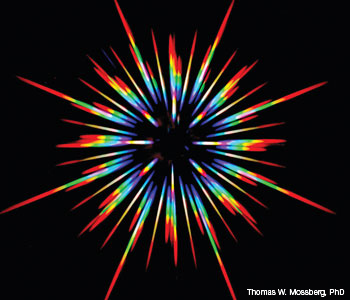Light Touch
A Brief History of the Starbow
The rise and fall—and rise again—of an intriguing concept about relativistic space travel.
 The diffraction pattern from a faceted silicon plate resembles the original conception of the starbow.
The diffraction pattern from a faceted silicon plate resembles the original conception of the starbow.
In Frederik Pohl’s 1972 Hugo-award-nominated novella The Gold at the Starbow’s End, a passenger aboard a starship traveling at about a third of the speed of light describes a beautiful effect caused by the relativistic color shifts of the stars. “It’s almost like a rainbow, one of those full-circle rainbows that you see on the clouds beneath you from an airplane,” according to the character. “Nearest the black hole in front the stars have frequency-shifted to a dull reddish color. They go through orange and yellow and a sort of leaf green to the band nearest the black hole in back, which are bright blue shading to purple…”
…Log in or become a member to view the full text of this article.
This article may be available for purchase via the search at Optica Publishing Group.
Optica Members get the full text of Optics & Photonics News, plus a variety of other member benefits.
